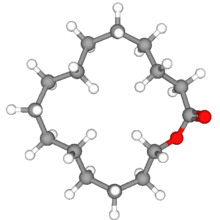Cyclopentadecanolide

| |

| |
| Names | |
|---|---|
| IUPAC name
Oxacyclohexadecan-2-one
| |
| Other names
Angelica lactone; Muskalactone; Muskolactone; Exaltolide; Pentalide; Pentadecanolide; Pentadecalactone; 15-Hydroxypentadecanoic acid, lactone; 15-Hydroxypentadecanoic acid-epsilon-lactone; Pentadecanoic acid, 15-hydroxy-, E-lactone; ω-Pentadecalactone; omega-Pentadecalactone; ω-Lactone; 2-Pentadecalone; Pentadecan-15-olide; 1,15-Pentadecanolide
| |
| Identifiers | |
3D model (JSmol)
|
|
| ChemSpider | |
| ECHA InfoCard | 100.003.050 |
| EC Number |
|
PubChem CID
|
|
CompTox Dashboard (EPA)
|
|
| |
| |
| Properties | |
| C15H28O2 | |
| Molar mass | 240.387 g·mol−1 |
| Appearance | colorless crystals |
| Odor | musklike |
| Density | 0.940 |
| Melting point | 37 to 38 °C (99 to 100 °F; 310 to 311 K) |
| Boiling point | 169 °C (336 °F; 442 K) |
Except where otherwise noted, data are given for materials in their standard state (at 25 °C [77 °F], 100 kPa).
| |
Cyclopentadecanolide is a natural macrolide lactone and a synthetic musk.
Natural occurrence
Cyclopentadecanolide occurs in small quantities in angelica root essential oil and is responsible for its musklike odor.[1]
Production
Cyclopentadecanolide is produced synthetically by ring expansion of cyclododecanone. Another synthesis route is the depolymerization of polyesters of 15-hydroxypentadecanoic acid.[1]
Uses
Cyclopentadecanolide is used as a musklike perfume fixative in fine fragrances and as a flavoring agent.[2] It is a substitute for the extremely expensive animal musk.[1]
References
- ^ a b c Karl-Georg Fahlbusch; et al. (2007), "Flavors and Fragrances", Ullmann's Encyclopedia of Industrial Chemistry (7th ed.), Wiley, p. 75
- ^ George A. Burdock (2010), "ω-PENTADECALACTONE", Fenaroli's Handbook of Flavor Ingredients (6th ed.), Taylor & Francis, p. 1597
